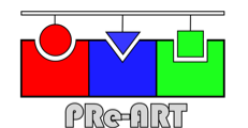Project leader
Birte Höcker
Project coworkers and collaborators
Felix Schwägerl
Josef Kynast
Horst Lechner
Noelia Ferruz
Introduction
We study the evolution of protein folds and functions to understand structure-function relationships and to use this data to develop strategies for protein engineering and design. Examples of our work include the combination of fragments from different folds to construct new proteins, the de novo design of an idealized four-fold symmetric TIM-barrel as well as the change of ligand-specificity in different binding proteins. In addition we are developing our own program code, e.g. PocketOptimizer to optimize predictability of ligand binding and help identify affinity changing mutations in proteins.
Addressing these questions in protein folding and ligand recognition requires an interdisciplinary approach and relies on the combination of experimental and theoretical methods. The spectrum of techniques we apply ranges from computational (sequence analysis and macromolecular modeling and design), via protein biochemistry (spectroscopy, calorimetry, and enzymology) to structural biology (X-ray crystallography and, in collaboration, NMR). The overarching goal is to achieve a better understanding of protein folding and small molecule recognition by studying the evolutionary history of proteins and by applying the gained knowledge to further advance the rational design of proteins.
Role of UBT within the PRe-ART Consortium
The main role of UBT within this project will be modelling and optimization by computational design.
Selected References
Banda-Vázquez, J., Shanmugaratnam, S., Rodríguez-Sotres, R., Torres-Larios, A., Höcker, B. & Sosa-Peinado, A. (2018). Redesign of LAOBP to bind novel L-amino acid ligands. Protein Sci. Mar 10, doi: 10.1002/pro.3403.
Stiel, A., Nellen, M. & Höcker, B. (2016) PocketOptimizer and the design of ligand binding sites. Methods Mol. Biol. 1414, 63-75.
Huang, P.-S.*, Feldmeier, K.*, Parmeggiani, F., Fernandez Velasco, D.A., Höcker, B. & Baker, D. (2016) De novo design of a four-fold symmetric TIM-barrel protein with atomic-level accuracy. Nature Chem. Biol. 12, 29-34.
Stiel, A., Feldmeier, K. & Höcker, B. (2014) Identification of protein scaffolds for enzyme design using ScaffoldSelection. Methods Mol. Biol. 1216, 183-196.
Scheib, U., Shanmugaratnam, S., Farias-Rico, J.A. & Höcker, B. (2014) Change in protein-ligand specificity through binding pocket grafting. J. Struc. Biol. 185, 186-192.
Feldmeier, K. & Höcker, B. (2013) Computational protein design of ligand binding and catalysis. Curr. Opin. Chem. Biol. 17, 929-933.
Farias-Rico, J.A. & Höcker, B. (2013) Design of chimeric proteins by combination of subdomain-sized fragments. Methods Enzymol. 523, 389-405.
Malisi, C., Schumann, M., Toussaint, N.C., Kageyama, J., Kohlbacher, O. & Höcker, B. (2012) Binding pocket optimization by computational protein design. PLoS One 7(12), e52505.
Shanmugaratnam, S., Eisenbeis, S. & Höcker, B. (2012) A highly stable protein chimera built from fragments of different folds. Protein Eng. Des. Sel. 25, 699-703.
Eisenbeis, S., Proffitt, W., Coles, M., Truffault, V., Shanmugaratnam, S., Meiler, J. & Höcker, B. (2012) The potential of fragment recombination for the rational design of proteins.
J. Am. Chem. Soc. 134, 4019-22.
Malisi, C., Kohlbacher, O. & Höcker, B. (2009) Automated scaffold selection for enzyme design. Proteins 77, 74-83.

